 |
||||||||||||||||||||
 |
||||||||||||||||||||
 |
||||||||||||||||||||
 |
The panoramic 31st floor in the tower was host to Nearfield Acoustics and VAC. What appeared to be a multi-channel music display used Kevin Hayes' new VAC Standard Six all-triode 6-channel preamplifier ($6,000) and the new PHI 70 Ultriode Monos ($10,000/pr) that offer 70 watts of NFB, self-biasing output power into 2, 4, or 8 ohms. The sound from where I stood was distinctly treble-tipped and on the bright side, failing these ears once again in demonstrating the particular magic the large PipeDreams are said to possess but which, alas, I've never yet been able to really get in person. Still, the views from the top were tremendous. |
|||||||||||||||||||
 |
||||||||||||||||||||
 |
||||||||||||||||||||
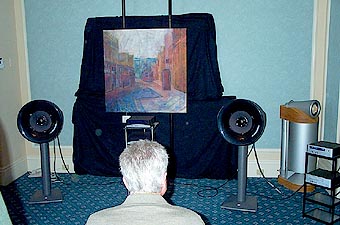 |
||||||||||||||||||||
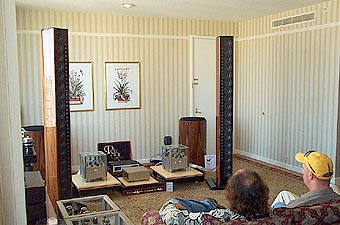 |
||||||||||||||||||||
 |
||||||||||||||||||||
| Resolution Audio's Jeff Kalt deserves the Interior Design Class award for not only the small-sized, aesthetically pleasing Opus 21 two-box CDP and the appropriately scaled custom shelving he brought; but for the creative effort to display two paintings by Elaine Coombs to dress up the devilishly tricky acoustics of a nearly perfectly cuboid room. |  |
|||||||||||||||||||
| Using Avantgarde's stylish self-amplified dual-concentric SOLO horns, this display made the best of what spatially is the most challenging of room geometries. | ||||||||||||||||||||
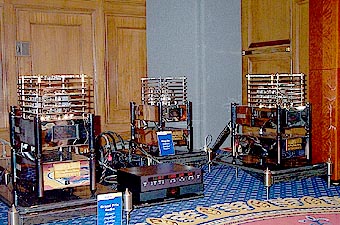 |
||||||||||||||||||||
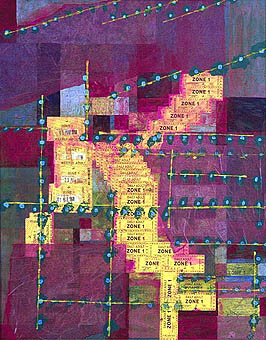 |
||||||||||||||||||||
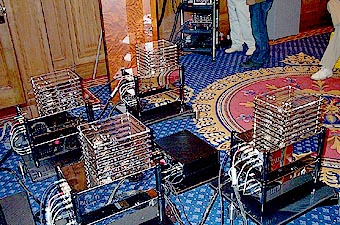 |
||||||||||||||||||||
| Fred Nadel of Pure Audio seemed like an audio version of my friend Siri Dharma Galliano whose Life Arts Pilates studio in Beverly Hills got Carie-Ann Moss in butt-kickin' shape for the 2nd and 3rd Matrix installments: Personal trainer to the stars. In Nadel's case, the Reformer, Chair and Trapeze Table made room for the brands Dali, Grand Prix Audio, Ming Da, Xindak and Zanden. | ||||||||||||||||||||
As conscientious dealer, Nadel offers different levels of on-site room acoustics measurements and treatments; power delivery and grounding optimization; setup tricks and resonance control. These value-added services perform the equivalent of the famous Pilates tuck that lifts sagging bottoms, slims the middle and tones the overall physique. Fred used HE2003 to premiere the $10,000/pr 70-watt Ming Da monoblocks that sport paralleled 845s driven by 300Bs and use a massive 60 lbs. double-decker architecture to separate the power supply from the signal circuitry. One glance at these beauties gave away who supplies the shell for the Sophia Electric 300B S.E.T. MkII. That's high compliment indeed for those who've read my short-changed review of the latter, with its barely disguised enthusiasm over first-rate build quality. In a way, the little $1,995 Ming Da MC67/HA preamp with MM/MC phono stage and a total of 11 small-signal tubes (4 x 6N6 in power supply, 6 x 6992 in output stage, 3 x 6N3 for phono) was even more impressive. Having compared it to $6-7K contenders, Fred casually quipped that it did the job every bit as well if not better. And that on a $170,000 system. |
||||||||||||||||||||
 |
 |
|||||||||||||||||||
Equally imposing as the monos were the Dali Megaline triple-chassis ribbon towers ($35,000/pr) which, despite appearances, are simple line-source 2-way designs that combine three 2.5' ribbons and 12 x 6.5" woofers per side. Think of them as a Danish version of the Pipe Dreams or Bo Bengsston's original Red Rose Music statements speakers. Inspecting "le rac", GPA's Alvin Lloyd present at the time confided that this SE version of the Monaco was in fact the result of a commission - from Fred Nadel himself. It sports double-wall tubing for the uprights, the outer air space filled with the same custom compound that separates the outer and inner layers of the Apex footers. Further SE refinements? 3"-thick triple-laminate shelves whose outer carbon hull disguises a complex inner Kevlar matrix, and standard Apex spike replacements. Yamada-San's Zanden Model 5000 MkIII provided thermionic 16bit/44.1kHz bit conversion without oversampling while MBL's mighty 1621 spun the discs. A Shunyata Hydra and Sound Application XE-12 buffered from powerline nasties. Behind the scenes, Xindak's FS-01 5-Nines Copper Foil Speaker Cables($595/pr/m, $150 per additional meter) and ASC-2 Active Signal Interconnect ($1,495/pr/m, $300 per additional meter, coaxial only) passed on the signal. This SEEC cable uses a high-resolution in-line miniature amp to enable 20 meter runs without signal degradation - or so the product propaganda claims. |
||||||||||||||||||||
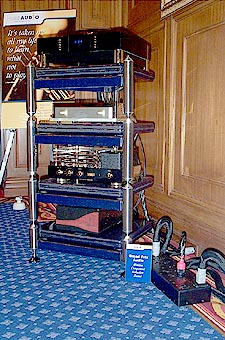 |
||||||||||||||||||||
This room was a favorite of Stereophile columnist John Marks who returned to it frequently like a thirsty man in the desert. And what was not to like? The Ming Da amps controlled the paralleled Dali woofers with aplomb, the physical height of the towers cast a life-sized, well-focused soundstage, and the speed and concomitant dynamics of the paralleled drivers doing minimum piston duty was quite invigorating. Chatting with Nadel post-show, I left deeply impressed not just with his specialist savoir-faire (how, for example, do you optimize grounding sans ionic transfer in sandy desert conditions) but his commitment to going far beyond moving boxes and assuring his customers a maximally optimized installation. Having been in retail myself, I appreciate what's involved. Hats off - okay, it's just a baseball cap but you get zee drift. |
||||||||||||||||||||
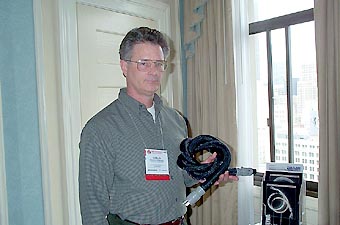 |
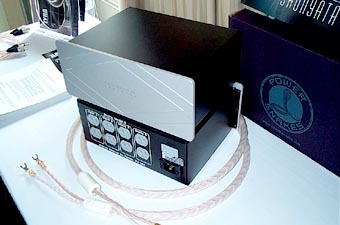 |
|||||||||||||||||||
Caelin Gabriel of Shunyata Research had lamented the silly stiffness of certain pricey low-gauge power cords in our recent industry features interview. Putting his knot where his mouth was, he twisted the mighty 7-AWG Anaconda Alpha into a proverbial Gordian and slyly grinned at my perplexed reaction. This is one SOTA power cord that won't bench-press your component off the shelf, shear off jacks or poke out your eye while losing your grip during wrestling it into place. I love it when folks not only rightly critique certain audiophile nonsense but then proceed to prove how it can be done better. Possibly the most highly anticipated new product introduction in the power delivery arena? The new Shunyata Hydra-8 ($1,995). It adds two outlets, capacitive custom filtering, surge protection, a magnetic circuit breaker and costs less than its predecessor. I also learned that Shunyata had finally been awarded its patent for the FeSi designs, with a second patent granted for Thierry Budge's Matrix cable geometry in the Shunyata speaker cables that now slyly has found its way also into the two Anaconda power cords. Further news? A forthcoming heavily shielded version of the $650 Aries interconnect dubbed the Aries S ($959). It's designed for metropolitan environments like NYC that run rampant with intense RFI contamination and require shielding. |
||||||||||||||||||||
| Silverline's Alan Yun introduced the $8,000/pr Bolero, a 3-driver 3-way with Dynaudio's Esotar T330D 1.25" soft dome tweeter, 15WLQ Esotec 5-inch midrange with 3" vc, and the 24W100X long-throw 9-incher with 4" vc. Beautifully finished in gloss Tigris and weighing in at a substantial 105 lbs, with 28Hz-32kHz claimed response and 92dB sensitivity, Alan threw me a curve ball when I entered. "Hey Srajan, haven't seen you in years." "Well, no, you saw me in Vegas a few months ago." "No, no - and I barely recognized you with your beard." "Alan, I've had this beard since I was 21." This hyped attempt at familiarity struck me as so fake and unpleasant that I made a turn-about on the spot and bailed. Alan will have to catch me with a different line next time - or perhaps I was just a bit run down and couldn't cope with such a dose of - er, enthusiasm? | ||||||||||||||||||||
 |
||||||||||||||||||||
| Sim Audio used to offer three tiers of products, then consolidated them all into the top Moon series. The launch of the new Moon Equinox ($1,995) in the wake of the Eclipse and Nova CD players suggests a return to the good-better-best recipe, albeit now all under the Moon banner. And who am I to disagree? Intended as source companion for the Moon i-3 integrated and based on circuitry developed for the Nova CD and Orion DVD player, the cleverly contoured Equinox offers BurrBrown 1730E 24/96 DACs, proprietary 1st-order analog filter identical to the one in the Eclipse and 25ppm digital clocking for low intrinsic jitter. This looks to be an exceptional digital value, and fit'n'finish were first-rate. | ||||||||||||||||||||
 |
||||||||||||||||||||
 |
||||||||||||||||||||
| Sound Application's Jim Weil had a plethora of permutations on his well-regarded XE-12 power line conditioner to suit different budgets and requirements. The Goldmund/Talon Firebird system could have used a larger space to truly strut its stuff so we ended up shooting the audiophile doodoo and catching up. Like Caelin Gabriel, Lloyd Walker of Walker Audio, Dan Babineau of Running Springs and Jerry Ramsey of Audio Magic, Jim is way deep into the power equation and could make your head spin with all the esoteric exotica that become of concern when you're going for it 110% in this respective arena. | ||||||||||||||||||||
 |
 |
|||||||||||||||||||
 |
||||||||||||||||||||